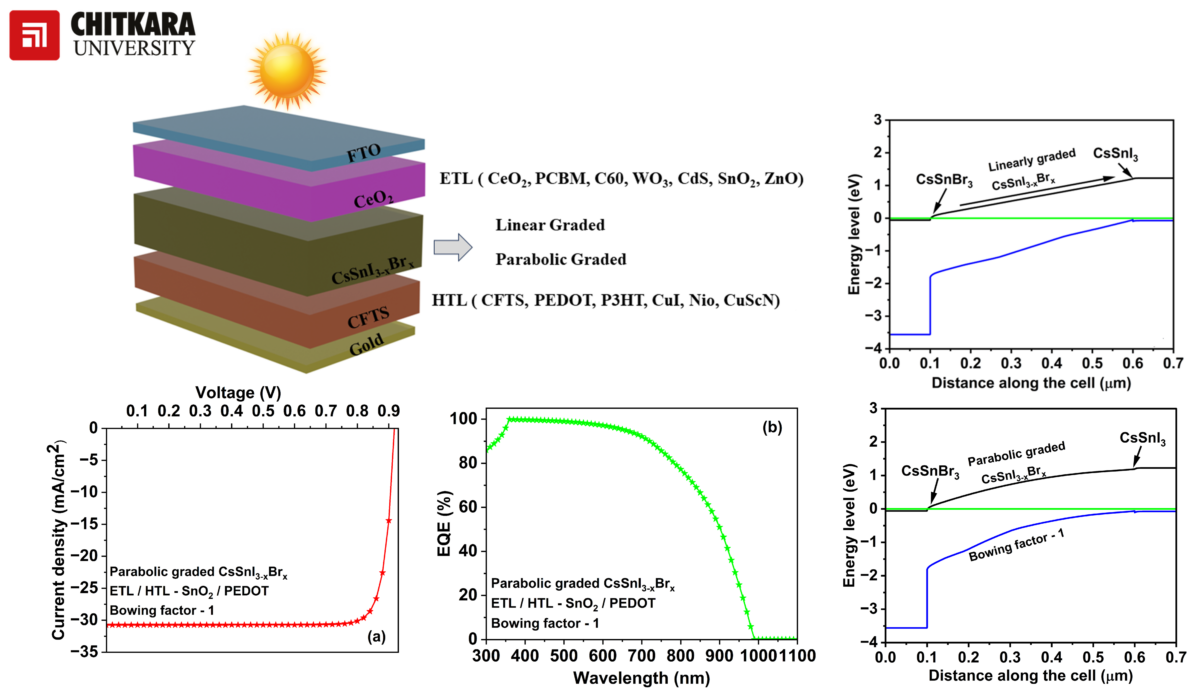Researchers from Chiktara University in India claim to have succeeded in improving the stability and performance of organic-inorganic perovskite solar cells by applying a strategy called bandgap grading.
It consists of enabling the cell perovskite absorber to collect a wider range of light photons by modifying its thickness and characteristics. “Our study demonstrates the effectiveness of both linear and parabolic bandgap grading strategies in optimizing light absorption and boosting performance,” the research's lead author, Jaya Madan, told pv magazine. “Parabolic grading emerges as particularly promising.”
The scientists used the SCAPS-1D solar cell capacitance software, developed by the University of Ghent, to simulate the novel cell configuration. They assumed the cell to rely on a lead-free, tin-based perovskite material known as CsSnI3-xBrx. “The incorporation of bandgap tailoring leads to modulated bandgap/affinity along the depth of the absorber layer, which uplifts the efficiency of the solar cell,” they explained.
The cell was initially designed to have a substrate made of fluorine-doped tin oxide (FTO), an electron transport layer (ETL) based on ceric oxide (CeO2), the perovskite absorber, a hole transport layer (HTL) made with copper, iron and tin (Cu2FeSnS4), and a gold (Au) metal contact.
For both the ETL and the HTL the thickness was assumed to be 100 nm, while for the absorber the academics considered a thickness ranging from 50 nm to 500 MW, with variable bandgap energy comprised between 1.25 eV and 1.78 eV.
Popular content
Tested assuming standard illumination conditions, the proposed solar cell configuration achieved a power conversion efficiency of 23.61 % with the parabolic grading approach and 21.68 % with linear grading. The simulations also showed that by replacing the utilized ETL and HTL materials with tin oxide (SnO2) and PEDOT:PSS, respectively, the efficiency of the cell may also exceed 24%.
The new solar cell concept was described in the study “Maximizing photovoltaic performance of all-inorganic perovskite CsSnI3-xBrx solar cells through bandgap grading and material design,” published in Solar Energy.
“Our research presents a compelling pathway towards realizing high-performance, sustainable, and stable perovskite solar cells,” concluded Madan. “The advancements in bandgap engineering and material design showcased in this study hold great promise for accelerating the commercialization of lead-free perovskite photovoltaic technologies.”
This content is protected by copyright and may not be reused. If you want to cooperate with us and would like to reuse some of our content, please contact: editors@pv-magazine.com.



By submitting this form you agree to pv magazine using your data for the purposes of publishing your comment.
Your personal data will only be disclosed or otherwise transmitted to third parties for the purposes of spam filtering or if this is necessary for technical maintenance of the website. Any other transfer to third parties will not take place unless this is justified on the basis of applicable data protection regulations or if pv magazine is legally obliged to do so.
You may revoke this consent at any time with effect for the future, in which case your personal data will be deleted immediately. Otherwise, your data will be deleted if pv magazine has processed your request or the purpose of data storage is fulfilled.
Further information on data privacy can be found in our Data Protection Policy.